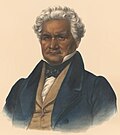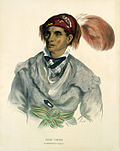Cherokee
The Cherokee (Cherokee: ᎠᏂᏴᏫᏯᎢ, romanized: Aniyvwiyaʔi or Anigiduwagi) are Native American tribes.
Cherokee Nation ᎠᏂᏴᏫᏯᎢ | |||||||||
|---|---|---|---|---|---|---|---|---|---|
 | |||||||||
| Capital | Tahlequah, Oklahoma | ||||||||
| Official languages | Cherokee language | ||||||||
| Demonym(s) | Cherokee | ||||||||
| Government | Tribe Indian reservation | ||||||||
| History | |||||||||
• | c. 1500 | ||||||||
| |||||||||
| Today part of | United States | ||||||||
When Europeans first arrived in the 16th century, the Cherokee lived in the modern-day eastern and southeastern United States. However, the United States government forced most to move to the Ozark Hills.
The Cherokee were named one of "Five Civilized Tribes."
History
Cherokee people did not live in tepees. They lived in houses made from wood.
In the 19th century, a man named Sequoyah introduced a form of writing the Cherokee language. For this, he was awarded a medal.
The Cherokee tribe had two chiefs, a red and white chief. When the tribe was at war, the red chief would lead, and when there was peace within the tribe, the white chief would lead.[1]
Chief John Ross was the leader of the Cherokee tribe from 1818 until 1867. He lived in Georgia before being forced to move to the place now called Oklahoma.
Tribes today
The U.S. government officially recognizes three Cherokee tribes:[2][3]
- Cherokee Nation in Oklahoma.
- United Keetoowah Band of Cherokee Indians in Oklahoma.
- Eastern Band of Cherokee Indians in North Carolina.
Cherokee Media
Portrait of Major John Norton (Mohawk chief) as Mohawk Chief Teyoninhokarawen by Mather Brown, ca. 1805. Yale Center for British Art (his father was a Cherokee while John Norton adopted by the Mohawks)
Portrait of Major Ridge in 1834, from History of the Indian Tribes of North America.
Cherokee National Council building, New Echota
Chief John Ross, c. 1840
Cherokee beadwork sampler, made at Dwight Mission, Indian Territory, 19th century, collection of the Oklahoma History Center
Cól-lee, a Band Chief, painted by George Catlin, 1834
A Cherokee speaker speaking English and Cherokee
References
| Wikimedia Commons has media related to Lua error in Module:Commons_link at line 62: attempt to index field 'wikibase' (a nil value).. |
- ↑ Crawford O'Brien, Suzanne (2005). American Indian religious traditions : an encyclopedia. Dennis F. Kelley. Santa Barbara, Calif. pp. 69–72. ISBN 1-57607-520-6. OCLC 61367206.
- ↑ Indians.org
- ↑ "National Conference of State Legislators". Archived from the original on 2021-05-05. Retrieved 2016-03-20.








